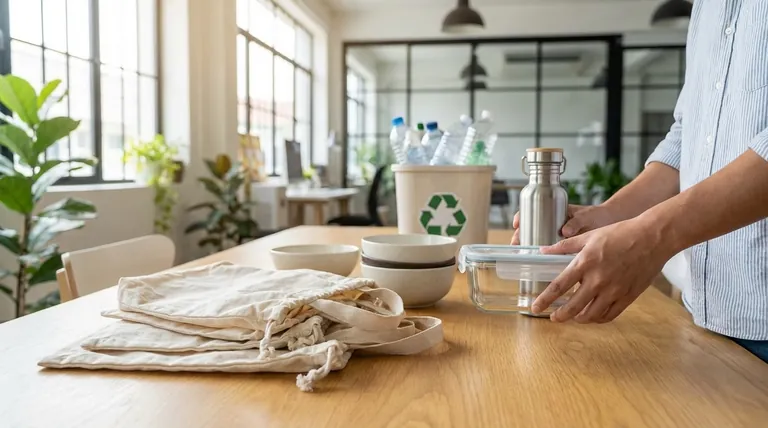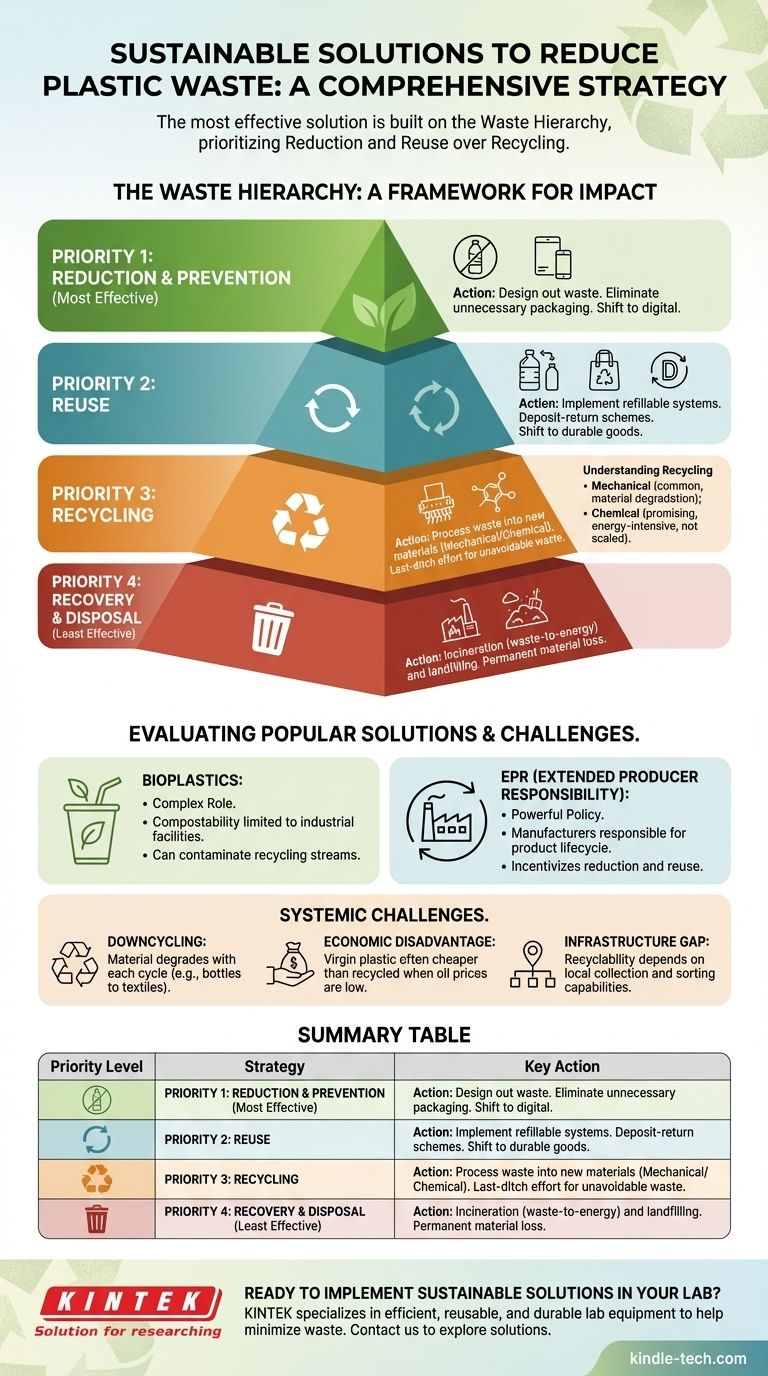بينما لا توجد تقنية واحدة تقدم حلاً سحريًا، فإن الحل الأكثر فعالية واستدامة للحد من النفايات البلاستيكية هو استراتيجية شاملة مبنية على هرم النفايات. يحدد هذا الإطار أولويات الإجراءات حسب التأثير البيئي، مع التركيز الأكبر على التخفيض وإعادة الاستخدام قبل وقت طويل من التفكير في إعادة التدوير. يعالج هذا النهج المشكلة من مصدرها، بدلاً من مجرد إدارة الأعراض.
الخطأ الجوهري هو التركيز على إعادة التدوير كحل أساسي. يتم تحقيق الاستدامة الحقيقية من خلال إعادة التفكير جذريًا في التصميم والاستهلاك والسياسة للقضاء على الحاجة إلى البلاستيك أحادي الاستخدام من البداية.

الأساس: فهم هرم النفايات
هرم النفايات هو إطار عمل مقبول عالميًا يوجه إدارة النفايات المستدامة. يصنف خيارات إدارة النفايات من الأكثر تفضيلاً إلى الأقل، مما يجبر على تحويل التركيز من المشاكل النهائية (مثل إعادة التدوير) إلى الحلول الأولية (مثل الوقاية).
الأولوية 1: التخفيض والوقاية
هذه هي الخطوة الأكثر تأثيرًا. البلاستيك الأكثر استدامة هو الذي لا يتم إنتاجه أبدًا.
يتضمن التخفيض تصميم أنظمة ومنتجات تتطلب مواد أقل أو لا تحتوي على بلاستيك على الإطلاق. وهذا يشمل القضاء على التعبئة والتغليف غير الضرورية، و"تخفيف وزن" المنتجات الأساسية، والتحول إلى البدائل الرقمية.
الأولوية 2: إعادة الاستخدام
إذا تعذر التخلص من البلاستيك، فإن الخيار الأفضل التالي هو إبقائه قيد الاستخدام لأطول فترة ممكنة في شكله الأصلي.
تحافظ أنظمة إعادة الاستخدام، مثل الحاويات القابلة لإعادة التعبئة للمشروبات ومنتجات التنظيف أو أنظمة الإيداع والاسترداد، على قيمة المادة وتقلل بشكل كبير من الطاقة والموارد اللازمة لإنشاء عناصر جديدة. إنه يمثل تحولًا من عقلية الاستخدام مرة واحدة إلى عقلية المتانة.
الأولوية 3: إعادة التدوير
إعادة التدوير هي عملية استعادة البلاستيك الخردة أو النفايات وإعادة معالجتها لإنتاج منتجات جديدة. إنها جزء أساسي من الحل، ولكنها الخيار الثالث الأفضل لسبب وجيه.
بينما تحول المواد عن مدافن النفايات، فإن العملية لها قيود كبيرة، بما في ذلك استهلاك الطاقة، وتدهور المواد، وقضايا التلوث. يجب أن يُنظر إليها على أنها محاولة أخيرة للعناصر التي لا يمكن التخلص منها أو إعادة استخدامها.
الملاذ الأخير: الاستعادة والتخلص
يشمل هذا المستوى عمليات مثل الحرق لإنتاج الطاقة، وبشكل أقل استحسانًا، الدفن في مدافن النفايات. هذه الخيارات مخصصة للنفايات التي لا يمكن منعها أو إعادة استخدامها أو إعادة تدويرها، وتؤدي إلى فقدان دائم للموارد المادية.
تقييم "الحلول" الشائعة من خلال هذه العدسة
تكتسب العديد من الحلول المقترحة اهتمامًا إعلاميًا، ولكن يمكن تقييم استدامتها الحقيقية باستخدام هرم النفايات.
دور البلاستيك الحيوي
غالبًا ما يُقدم البلاستيك الحيوي كحل بسيط، لكن دوره معقد. بعضها مصمم ليكون قابلاً للتحلل، ولكن فقط في المنشآت الصناعية، وليس في سلة المهملات المنزلية أو البيئة المفتوحة.
علاوة على ذلك، يمكن أن يكون لإنتاجها بصمتها البيئية الخاصة المتعلقة باستخدام الأراضي والمياه. إذا دخلت مسارات إعادة تدوير البلاستيك التقليدية، فإنها تعمل كملوث، مما قد يدمر دفعات كاملة من المواد القابلة لإعادة التدوير.
قوة مسؤولية المنتج الموسعة (EPR)
مسؤولية المنتج الموسعة (EPR) هي نهج سياسي يجعل المصنعين مسؤولين عن دورة حياة منتجاتهم بأكملها، بما في ذلك جمعها والتخلص النهائي منها.
هذه رافعة قوية لـ التخفيض وإعادة الاستخدام. عندما تتحمل الشركات التكلفة المالية لنفايات تغليفها، يتم تحفيزها مباشرة لتصميم منتجات أخف وزنًا، وأسهل في إعادة الاستخدام، وأكثر كفاءة في إعادة التدوير.
إعادة التدوير الكيميائي مقابل الميكانيكي
إعادة التدوير الميكانيكي، وهو النوع الأكثر شيوعًا، يتضمن تمزيق البلاستيك وغسله وصهره وإعادة تشكيله. تستخدم إعادة التدوير الكيميائي (أو "إعادة التدوير المتقدمة") عمليات مختلفة لتفكيك البلاستيك إلى مكوناته الجزيئية الأصلية، والتي يمكن بعد ذلك استخدامها لإنشاء بلاستيك جديد بجودة بكر.
بينما تحمل إعادة التدوير الكيميائي وعدًا بمعالجة البلاستيك المختلط الذي يصعب إعادة تدويره، إلا أنها حاليًا كثيفة الاستهلاك للطاقة، وغالبًا ما تكون ذات إنتاجية منخفضة، ولم تثبت بعد على نطاق واسع ومجدٍ اقتصاديًا.
فهم المقايضات والتحديات النظامية
يتطلب تحقيق اقتصاد دائري للبلاستيك الاعتراف بالعقبات الكبيرة الموجودة داخل النظام الحالي.
أسطورة قابلية إعادة التدوير اللانهائية
معظم أنواع البلاستيك الشائعة لا يمكن إعادة تدويرها إلى ما لا نهاية. تتسبب عملية صهر البلاستيك وإعادة تشكيله في تدهور سلاسل البوليمر، وهي ظاهرة تُعرف باسم التدوير الهابط.
بعد بضع دورات، تفقد المادة سلامتها الهيكلية ويجب استخدامها لمنتجات ذات جودة أقل (مثل زجاجات البلاستيك التي تصبح منسوجات أو أخشاب) حتى يتم دفنها أو حرقها في النهاية.
الجانب الاقتصادي السلبي
يجب أن يتنافس البلاستيك المعاد تدويره مع البلاستيك البكر، الذي يتم إنتاجه مباشرة من الوقود الأحفوري. عندما تكون أسعار النفط منخفضة، غالبًا ما يكون البلاستيك البكر أرخص وأعلى جودة من نظيره المعاد تدويره، مما يخلق حافزًا اقتصاديًا ضعيفًا للمصنعين لاستخدام المحتوى المعاد تدويره.
فجوة البنية التحتية
قابلية المنتج لإعادة التدوير لا معنى لها بدون البنية التحتية المحلية لجمعه وفرزه ومعالجته. تختلف توفر وقدرة مرافق إعادة التدوير بشكل كبير بين البلديات والبلدان، مما يؤدي إلى ارتباك واسع النطاق للمستهلكين ومعدلات إعادة تدوير فعلية منخفضة.
اتخاذ الخيار الصحيح لهدفك
للمساهمة بفعالية في الحل، يجب أن تتوافق أفعالك مع هرم النفايات.
- إذا كنت مصمم منتجات أو قائد أعمال: يجب أن يكون تركيزك الأساسي على تصميم النفايات خارجًا من البداية من خلال استكشاف المواد الخالية من البلاستيك والاستثمار في أنظمة إعادة الاستخدام وإعادة التعبئة القوية.
- إذا كنت صانع سياسات: أعط الأولوية للتشريعات مثل مسؤولية المنتج الموسعة (EPR) وقدم التمويل للبنية التحتية لإعادة الاستخدام، مما يخلق حوافز أولية لتقليل النفايات.
- إذا كنت مستهلكًا فرديًا: تكمن قوتك الأكبر في تقليل استهلاك العناصر أحادية الاستخدام واختيار البدائل القابلة لإعادة الاستخدام بنشاط، مما يجعل إعادة التدوير خيارك الأخير، وليس الأول.
يتحقق مستقبل مستدام للبلاستيك ليس من خلال إدارة النفايات بشكل أفضل، ولكن من خلال إنشاء نظام اقتصادي واجتماعي لا ينتجها في المقام الأول.
جدول الملخص:
| مستوى الأولوية | الاستراتيجية | الإجراء الرئيسي |
|---|---|---|
| 1 (الأكثر فعالية) | التخفيض والوقاية | تصميم النفايات خارجًا، التخلص من التعبئة والتغليف غير الضرورية |
| 2 | إعادة الاستخدام | تطبيق أنظمة قابلة لإعادة التعبئة، أنظمة الإيداع والاسترداد |
| 3 | إعادة التدوير | معالجة النفايات إلى مواد جديدة (ميكانيكية/كيميائية) |
| 4 (الأقل فعالية) | الاستعادة والتخلص | الحرق، الدفن في مدافن النفايات كملاذ أخير |
هل أنت مستعد لتطبيق حلول مستدامة في مختبرك؟ تتخصص KINTEK في معدات ومستهلكات المختبرات، مما يساعد المختبرات على تقليل النفايات من خلال منتجات فعالة وقابلة لإعادة الاستخدام ومتينة. دعنا ندعم أهدافك المتعلقة بالاستدامة—اتصل بخبرائنا اليوم لاستكشاف كيف يمكن لحلولنا أن تقلل من تأثيرك البيئي مع الحفاظ على الأداء العالي.
دليل مرئي

المنتجات ذات الصلة
- فيلم تغليف مرن من الألومنيوم والبلاستيك لتغليف بطاريات الليثيوم
- شركة مصنعة مخصصة للأجزاء المصنعة والمقولبة من PTFE Teflon للزجاج الموصل ITO FTO للمختبرات وسلال الزهور
- فرن دوار كهربائي صغير لتقطير الكتلة الحيوية
- مصنع مخصص لأجزاء التيفلون PTFE لرفوف التنظيف
- وحدة تقطير المياه المثبتة على الحائط
يسأل الناس أيضًا
- ما هي تقنية النفخ لإنتاج الأفلام؟ دليل لإنتاج أفلام بلاستيكية عالية القوة
- ما هو الطلاء الأرق؟ إطلاق العنان للخصائص الفريدة على المستوى الذري
- ما هي تطبيقات أشباه الموصلات الرقيقة؟ من الرقائق الدقيقة إلى الطاقة الشمسية
- ما هو الفرق بين الفيلم أحادي الطبقة والفيلم متعدد الطبقات؟ اختر التغليف المناسب لمنتجك
- ما هو الغرض من التغليف؟ حماية مستنداتك وتعزيزها للاستخدام طويل الأمد







